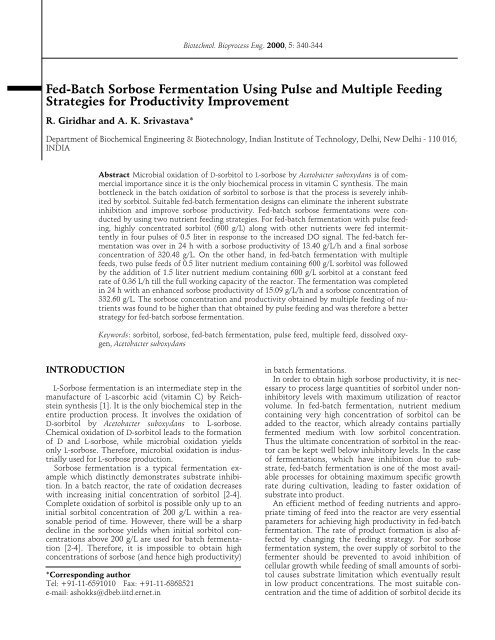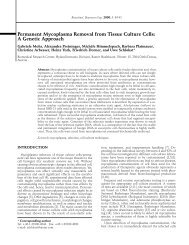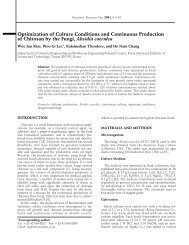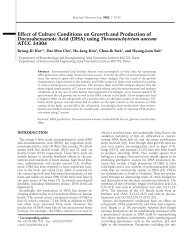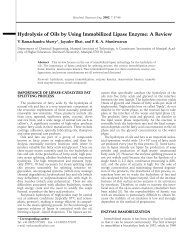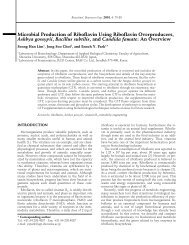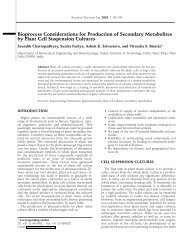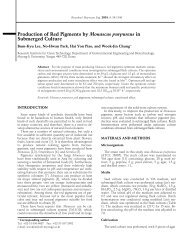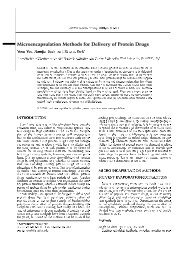Fed-Batch Sorbose Fermentation Using Pulse and Multiple Feeding ...
Fed-Batch Sorbose Fermentation Using Pulse and Multiple Feeding ...
Fed-Batch Sorbose Fermentation Using Pulse and Multiple Feeding ...
- No tags were found...
Create successful ePaper yourself
Turn your PDF publications into a flip-book with our unique Google optimized e-Paper software.
Biotechnol. Bioprocess Eng. 2000, 5: 340-344<strong>Fed</strong>-<strong>Batch</strong> <strong>Sorbose</strong> <strong>Fermentation</strong> <strong>Using</strong> <strong>Pulse</strong> <strong>and</strong> <strong>Multiple</strong> <strong>Feeding</strong>Strategies for Productivity ImprovementR. Giridhar <strong>and</strong> A. K. Srivastava*Department of Biochemical Engineering & Biotechnology, Indian Institute of Technology, Delhi, New Delhi - 110 016,INDIAAbstract Microbial oxidation of D-sorbitol to L-sorbose by Acetobacter suboxydans is of commercialimportance since it is the only biochemical process in vitamin C synthesis. The mainbottleneck in the batch oxidation of sorbitol to sorbose is that the process is severely inhibitedby sorbitol. Suitable fed-batch fermentation designs can eliminate the inherent substrateinhibition <strong>and</strong> improve sorbose productivity. <strong>Fed</strong>-batch sorbose fermentations were conductedby using two nutrient feeding strategies. For fed-batch fermentation with pulse feeding,highly concentrated sorbitol (600 g/L) along with other nutrients were fed intermittentlyin four pulses of 0.5 liter in response to the increased DO signal. The fed-batch fermentationwas over in 24 h with a sorbose productivity of 13.40 g/L/h <strong>and</strong> a final sorboseconcentration of 320.48 g/L. On the other h<strong>and</strong>, in fed-batch fermentation with multiplefeeds, two pulse feeds of 0.5 liter nutrient medium containing 600 g/L sorbitol was followedby the addition of 1.5 liter nutrient medium containing 600 g/L sorbitol at a constant feedrate of 0.36 L/h till the full working capacity of the reactor. The fermentation was completedin 24 h with an enhanced sorbose productivity of 15.09 g/L/h <strong>and</strong> a sorbose concentration of332.60 g/L. The sorbose concentration <strong>and</strong> productivity obtained by multiple feeding of nutrientswas found to be higher than that obtained by pulse feeding <strong>and</strong> was therefore a betterstrategy for fed-batch sorbose fermentation.Keywords: sorbitol, sorbose, fed-batch fermentation, pulse feed, multiple feed, dissolved oxygen,Acetobacter suboxydansINTRODUCTIONL-<strong>Sorbose</strong> fermentation is an intermediate step in themanufacture of L-ascorbic acid (vitamin C) by Reichsteinsynthesis [1]. It is the only biochemical step in theentire production process. It involves the oxidation ofD-sorbitol by Acetobacter suboxydans to L-sorbose.Chemical oxidation of D-sorbitol leads to the formationof D <strong>and</strong> L-sorbose, while microbial oxidation yieldsonly L-sorbose. Therefore, microbial oxidation is industriallyused for L-sorbose production.<strong>Sorbose</strong> fermentation is a typical fermentation examplewhich distinctly demonstrates substrate inhibition.In a batch reactor, the rate of oxidation decreaseswith increasing initial concentration of sorbitol [2-4].Complete oxidation of sorbitol is possible only up to aninitial sorbitol concentration of 200 g/L within a reasonableperiod of time. However, there will be a sharpdecline in the sorbose yields when initial sorbitol concentrationsabove 200 g/L are used for batch fermentation[2-4]. Therefore, it is impossible to obtain highconcentrations of sorbose (<strong>and</strong> hence high productivity)*Corresponding authorTel: +91-11-6591010 Fax: +91-11-6868521e-mail: ashokks@dbeb.iitd.ernet.inin batch fermentations.In order to obtain high sorbose productivity, it is necessaryto process large quantities of sorbitol under noninhibitorylevels with maximum utilization of reactorvolume. In fed-batch fermentation, nutrient mediumcontaining very high concentration of sorbitol can beadded to the reactor, which already contains partiallyfermented medium with low sorbitol concentration.Thus the ultimate concentration of sorbitol in the reactorcan be kept well below inhibitory levels. In the caseof fermentations, which have inhibition due to substrate,fed-batch fermentation is one of the most availableprocesses for obtaining maximum specific growthrate during cultivation, leading to faster oxidation ofsubstrate into product.An efficient method of feeding nutrients <strong>and</strong> appropriatetiming of feed into the reactor are very essentialparameters for achieving high productivity in fed-batchfermentation. The rate of product formation is also affectedby changing the feeding strategy. For sorbosefermentation system, the over supply of sorbitol to thefermenter should be prevented to avoid inhibition ofcellular growth while feeding of small amounts of sorbitolcauses substrate limitation which eventually resultin low product concentrations. The most suitable concentration<strong>and</strong> the time of addition of sorbitol decide its
Biotechnol. Bioprocess Eng. 2000, Vol. 5, No. 5 341ultimate concentration in the reactor.Some feeding strategies like exponential feeding, [4]intermittent addition [5] <strong>and</strong> gradient feeding [6] hadbeen reported for fed-batch sorbose fermentation. Srivastava<strong>and</strong> Lasrado [4] initiated the fed- batch fermentationwith an initial sorbitol concentration of 200 g/L<strong>and</strong> at 10 h of growth it was converted to fed-batch byfeeding nutrients containing 700 g/L sorbitol at an exponentiallyincreasing rate. Mori et al. [5] used an initialsorbitol concentration of 80 g/L <strong>and</strong> sorbitol powderwas supplied to the fermenter intermittently for fedbatchcultivation in a fermenter using a DO-stat. Theyalso used pure oxygen supply to the fermenter to maintain2-3 ppm level of oxygen. In the gradient fed-batchprocess adopted by Bosjnak et al. [6], batch fermentationwith an initial sorbitol concentration of 120 g/Lwas converted to fed-batch at 10 h of growth. Nutrientscontaining increasing sorbitol concentration (0-400g/L) was pumped into the reactor at constant feed rate.<strong>Feeding</strong> methods that couple addition of nutrients withmeasurement of various physical parameters like dissolvedoxygen concentration, pH, microbial heat <strong>and</strong>carbon dioxide evolution rate appears to be more efficientthan coupling the nutrient feeding with the timeof cultivation. Lee [7] has extensively reviewed the useof various feeding strategies that couple the physicalparameters for the fed-batch cultivation of E. coli. Theuse of DO-signal as an indicator for substrate feeding inother fermentation systems has been very well demonstratedby Yano et al. [8] for the fed-batch cultivation ofC<strong>and</strong>ida brassicae <strong>and</strong> Protaminobacter ruber. The presentstudy, investigates the use of pulse feeding <strong>and</strong> multiplefeeding strategies for feeding fresh sorbitol medium forthe fed-batch cultivation of Acetobacter suboxydans tomicrobially oxidize D-sorbitol to L-sorbose.MATERIALS AND METHODSChemicalsThe sorbitol used in this study was of commercialgrade (70% w/w) supplied by M/s Anil starch products,Ahmedabad, India. Yeast extract powder, ammoniumdihydrogen phosphate <strong>and</strong> magnesium sulphate werepurchased from M/s Qualigens fine chemicals, Mumbai,India. All chemicals were of analytical reagent (AR)grade.Microorganism <strong>and</strong> MaintenanceThe present investigation was carried out usingNRRL B-72 strain of Acetobacter suboxydans. Cultureswere maintained on agar slants having the composition(g/L): sorbitol, 5.0; yeast extract powder, 5.0; ammoniumdihydrogen phosphate, 3.0; magnesium sulphate,1.0; agar 20. The initial pH was 6.0. Samples taken after48 h growth at 30 o C was preserved at 4 o C.Inoculum DevelopmentA loop full of microorganism from the slant wastransferred into 0.01 liter medium in test tubes havingthe composition (g/L): Sorbitol, 5.0; yeast extract powder,5.0; ammonium dihydrogen phosphate, 3.0; magnesiumsulphate, 1.0; pH 6.0. The test tubes were incubatedat 30 o C for 72 h. The growth was characterisedby the appearance of a thick pellicle on the surface ofthe medium <strong>and</strong> uniform turbidity. It was then transferredinto 1.0 liter capacity flasks containing 100 mLmedium of composition (g/L): sorbitol, 5.0; yeast extractpowder, 5.0; ammonium dihydrogen phosphate,3.0; magnesium sulphate, 1.0; pH, 6.0. The flasks wereincubated in a rotary shaker (Adolf Kuhner, Switzerl<strong>and</strong>)at 30 o C <strong>and</strong> 250 rpm. Subsequent transfer into thefermenter was done when the biomass concentrationwas about 2.8 to 3.0 g/L.<strong>Fermentation</strong> ProcessConditions of <strong>Fermentation</strong>The fed-batch fermentations were carried out in a 7.0litre capacity fermenter (Bioengineering A.G., Switzerl<strong>and</strong>)equipped with two sets of flat blade turbine impellers.The working volume was 4.5 litres. The aerationrate <strong>and</strong> agitation speed were 2.2 vvm <strong>and</strong> 700 rpmrespectively. The temperature was maintained at 30 o C<strong>and</strong> the pH at 6.0 by the automatic addition of 3 NNaOH <strong>and</strong> 3 N HCl.<strong>Fed</strong>-batch <strong>Fermentation</strong> with <strong>Pulse</strong> Feed<strong>Fed</strong>-batch fermentation with pulse feed was startedas a batch with an initial sorbitol concentration of 100g/L. The concentration (g/L) of other nutrients were;yeast extract powder, 5.0; ammonium dihydrogenphosphate, 3.0 <strong>and</strong> magnesium sulphate, 1.0. Four pulsefeeds of 0.5 liter, 600 g/L sorbitol along with increasedproportion of other nutrients so that they are not limiting,were fed when the dissolved oxygen concentrationin the reactor increased abruptly (at hours 7, 12, 15 <strong>and</strong>20) indicating the depletion of carbon source. The fermentationwas stopped when all the sorbitol in themedium was exhausted as indicated by the increasedDO signal.<strong>Fed</strong>-batch <strong>Fermentation</strong> with <strong>Multiple</strong> FeedsThe fed-batch fermentation with multiple feeds wasstarted as a batch with an initial sorbitol concentrationof 100 g/L. The concentration of other nutrients in themedium were as given above in the fed-batch fermentationwith pulse feed. Two pulse feeds of 0.5 litres nutrientmedium containing 600 g/L sorbitol (with increasedproportion of other nutrients) were followed by theaddition of 1.5 liters of nutrient medium containing 600g/L sorbitol at a constant feed rate of 0.36 L/h. Firstnutrient pulse addition was done when the culture wasin the exponential phase (biomass = 2 g/L) Further nutrientadditions were done when the dissolved oxygen
342 Biotechnol. Bioprocess Eng. 2000, Vol. 5, No. 5concentration in the reactor started increasing indicatingthe substrate depletion. After two pulse additions aconstant feed rate of 0.36 L/h (Sorbitol concentration600 g/L) was maintained till the reactor was full. Thefermentation was terminated when no residual sorbitolin the reactor was available as indicated by the increasedDO signal.Dissolved Oxygen (DO) ConcentrationAn in situ Ingold dissolved oxygen probe was used forthe measurement of DO concentration in the fermenter.The DO concentration is indicated as % pO 2.Analytical TechniquesBiomass ConcentrationOptical density (OD) of the suitably diluted sampleswas measured at 600 nm in a UVIKON 930 spectrophotometer(Kontron Instruments, USA). Biomass wasestimated from an OD vs concentration (g/L) correlation,which was determined a priori as follows:Biomass concentration of a known volume of thesamples were determined gravimetrically after measuringthe OD at 600 nm. A st<strong>and</strong>ard curve was plotted betweenOD of the samples <strong>and</strong> their respective biomassconcentrations to arrive at the following correlation.Biomass (g/L) = 0.73 × OD 600Sorbitol <strong>and</strong> <strong>Sorbose</strong> ConcentrationsSorbitol <strong>and</strong> sorbose concentrations were estimatedby HPLC (Waters Associates, USA) using a SupelcosilLC-NH 2(Supelco, USA) column (25 cm × 4.6 mm ID)equipped with RI detector <strong>and</strong> using acetonitrile-water(75:25) as eluent with a flow rate of 1 ml/min at ambienttemperature.RESULTS AND DISCUSSION<strong>Fed</strong>-batch <strong>Fermentation</strong> with <strong>Pulse</strong> FeedFig. 1 shows the kinetics of fed-batch fermentationwith four pulse feeds of 0.5 litre containing S 0= 600g/L sorbitol. The fermentation was completed in 24hours with a final biomass <strong>and</strong> sorbose concentrationsof 12.24 <strong>and</strong> 320.48 g/L respectively. The fermentationalso demonstrated a sorbose productivity of 13.35 g L -1 h -1 .It can be seen from Fig. 1 that the maximum sorbitolconcentration in the reactor was about 105 g/L at 7.5hours of fermentation after the addition of first feedpulse consisting of 0.5 litre of 600 g/L sorbitol medium.Second sorbitol feed shot was quickly consumed. Presumablydue to high (<strong>and</strong> active) biomass concentrationin the reactor. However the last two sorbitol shots notonly diluted the existing sorbose concentration but ittook longer time (4-5 h) for total substrate consumption.This may be due to the dilution effect resultingfrom additional sorbitol feed for not so young (deterio-Fig. 1. <strong>Fed</strong>-batch sorbose fermentation by Acetobacter suboxydanswith pulse feed: 0-7 h batch (S 0= 100 g/L), 7-24 hfed-batch (4 pulse feeds of 0.5 L, 600 g/L sorbitol, at 7,12,15<strong>and</strong> 20 h) fermentation.rating) culture. However, by pulse feeding, the ultimateconcentration of sorbitol in the reactor could be maintainedwell below 200 g/L (high inhibitory concentration[4]) throughout the fermentation process.<strong>Fed</strong>-batch <strong>Fermentation</strong> with <strong>Multiple</strong> FeedsIn fed-batch fermentation with pulse feed (as describedabove) the fresh nutrient additions were donewhen DO increased, this invariably led to increase insubstrate, concentration but at the expense of dilutionof existing product concentration in the bioreactor.This may be because towards the end of the batchgrowth (when substrate concentration is close to zero)the culture activity eventually deteriorates, <strong>and</strong> at thattime growth <strong>and</strong> production rate during the feedingperiod of pulse substrate does not match the dilutionrate. Therefore it would be beneficial if the fresh nutrientfeed shots are added a little bit before the end of thefermentation preferably in the exponential phase ofgrowth. Similarly continuous linear feed as opposed toone time feed shot (pulse) may continuously supply thedepleting nutrients <strong>and</strong> not unnecessarily dilute theexisting fermentation broth with respect to biomass<strong>and</strong> product. In order to eliminate excess accumulationof high sorbitol concentrations in the fermentationbroth, it was decided to feed the nutrients at a relativelylower but constant feed rate of 0.36 L/h with S 0= 600 g/L after the second pulse feed as had been usedin Fig. 2. It was anticipated that during continuousfeeding the incoming sorbitol will be quickly consumedby the vigorously growing culture <strong>and</strong> not result in dilutiondue to fresh sorbitol feed as had happened in theearlier pulse feed case.Kinetics of fed-batch fermentation with multiple feeds(2 pulse feeds of 0.5 L, 600 g/L followed by fresh medium(with 600 g/L sorbitol) addition at a feed rate of0.36 L/h) is shown in Fig. 2. The fermentation wascompleted in 24 h with a sorbose productivity of 15.09g L -1 h -1 . The final biomass <strong>and</strong> sorbose concentrationswere 12.64 <strong>and</strong> 332.60 g/L, respectively. The sorbose
Biotechnol. Bioprocess Eng. 2000, Vol. 5, No. 5 343sorbitol powder to the fermenter enhanced the productivityto 44.85 g L -1 h -1 . Bosjnak et al. [6] could get a productivityof 11.62 g L -1 h -1 by gradient fed-batch fermentation.The present work demonstrated a productivityof 13.35 g L -1 h -1 for pulse feeding <strong>and</strong> 15.09 g L -1 h -1 formultiple feeding of nutrients for fed-batch fermentation,which are higher compared to the above investigatorsexcept Mori et al. [5]. However, the use of sorbitolpowder <strong>and</strong> pure oxygen supply to the fermenter usedin their investigation [5] may not be economically feasiblefor large scale industrial fermentations.CONCLUSIONSFig. 2. <strong>Fed</strong>-batch sorbose fermentation by Acetobacter suboxydanswith multiple feeds: 0-6 h batch (S 0= 100 g/L), 6–18h fed-batch (two pulse feeds of 0.5 L, 600 g/L sorbitol followedby 600 g/L sorbitol at constant feed rate of 0.36 L/h), <strong>and</strong> 18-22 h batch fermentation.concentration <strong>and</strong> productivity obtained by multiplefeeding was found to be higher than that obtained bypulse feeding of the nutrients. The improvement in sorboseaccumulation <strong>and</strong> productivity could be attributeddue to the following reasons.- The first pulse feed was added during the exponentialgrowth phase of the culture therefore the dilutiondue to fresh medium addition was not reflectedat all in the observed values of biomass <strong>and</strong> substrateas was the case with pulse feeding presumablybecause the incoming substrate was used upquickly during the feeding time <strong>and</strong> thereafter verylittle dilution effect was observed during the additionof second pulse feed <strong>and</strong> later on during theconstant feed. The culture growth clearly demonstratedpseudo steady state with respect to substrate<strong>and</strong> biomass during the constant feeding periodindicating the fresh nutrient feeding exactlybalanced the growth <strong>and</strong> product formation rate ofthe culture.- Also the sorbitol feeding during constant feed basicallymaintained high turn over production rates<strong>and</strong> vigourously growing culture (particularly without any dilution), which eventually resulted inhighly productive fermentation. The high sorboseconcentration (332.60 g/L) <strong>and</strong> productivity (15.09g L -1 h -1 ) obtained by the multiple feeding of sorbitolmade it a better processing strategy compared topulse feeding alone in response to DO increase.It was rather interesting to compare the productivitiesof this fermentation with the literature reportedfermentations. Srivastava <strong>and</strong> Lasrado [4] obtained aproductivity of 12.6 g L -1 h -1 by exponential feeding.Mori et al. [5] using pure oxygen supply <strong>and</strong> feedingThe substrate limitation in sorbitol to sorbose fermentationwas prominently indicated by abrupt increasein dissolved oxygen signal. The nutrient (substrate)limitation of sorbitol to sorbose fermentation byAcetobacter suboxydans was eliminated by adopting “Addsubstrate when low” technique(s). In one fed-batch fermentationpulse feed design was implemented. 0.5 Litersorbitol medium (containing 600 g/L sorbitol) wasadded in four, one-time shots (pulses) in response toabrupt increase of DO signal in the fermentation. Thisresulted in an overall sorbose productivity of 13.35 g L -1h -1 <strong>and</strong> final sorbose concentration of 320.48 g/L. Inanother fed-batch fermentation design two shots(pulses) of fresh nutrient (0.5 Liter, sorbitol concentration600 g/L) were added <strong>and</strong> thereafter a constantfresh nutrient supply ( sorbitol concentration 600 g/L)at a rate of 0.36 L/h was maintained in the reactor till itwas full. The above fed-batch resulted in sorbose accumulationof 332.60 g/L with an overall productivity of15.09 g L -1 h -1 . The pulse feed during the exponentiallygrowing culture <strong>and</strong> slow continuous substrate feedingwere much beneficial in improving the productivity offermentation as it did not excessively dilute the existingbiomass <strong>and</strong> product concentrations in the reactor. Thehigh sorbose concentration <strong>and</strong> productivity obtainedby multiple feeding strategies made it a better processingtechnique compared to the pulse feeding alone.REFERENCES[1] Bourdant, J. (1990) Microbial processes for ascorbic acidsynthesis: A review. Enzyme Microb. Technol. 12: 322-329.[2] Damodaran, M. <strong>and</strong> S. S. Subramanian (1951) Bacterialoxidation of sorbitol to sorbose. J. Sci. Ind. Res. 5(10): 7-13.[3] Bonomi, A., E. F. P. Augusto, N. S. Barbosa, M. N. Mattos,L. R. Magossi, <strong>and</strong> A. L. Santos (1993) Unstructuredmodel proposal for the microbial oxidation of D-Sorbitolto L-<strong>Sorbose</strong>. J. Biotechnol. 31: 39-59.[4] Srivastava, A. K. <strong>and</strong> P. R. Lasrado (1998) <strong>Fed</strong>-batch sorbitolto sorbose fermentation by A. suboxydans. Bioproc.Eng. 18: 457-461.[5] Mori, H., T. Kobayashi, <strong>and</strong> S. Shimizu (1981) High densityproduction of sorbose from sorbitol by fed-batch cul-
344 Biotechnol. Bioprocess Eng. 2000, Vol. 5, No. 5ture with DO-stat. J. Chem. Eng. Jpn. 14: 65-70.[6] Bosjnak, M., P. Pintar, <strong>and</strong> K. Gomercic (1991) Gradientfed-batch culture as efficient microbial oxidation method.Med. Fac. L<strong>and</strong>bouww. Rijksuniv. Gent. 56: 1723-1730.[7] Lee, S. Y. (1996) High cell-density culture of Escherichiacoli: Reviews. TIBTECH 14: 98-105.[8] Yano T., M. Kurokawa, <strong>and</strong> Y. Nishizawa (1991) Optimumsubstrate feed rate in fed-batch culture with theDO-stat method. J. Ferment. Bioeng. 71: 345-349.[Received June 22, 2000; accepted September 22, 2000]


